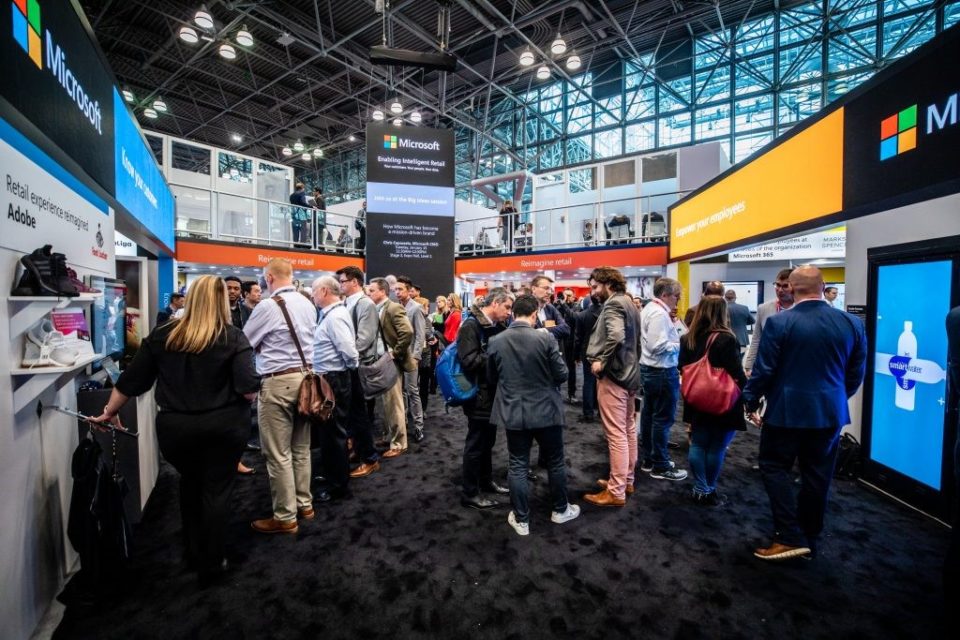By Raj Raguneethan, Asia Lead, Retail and Consumer Industries, Microsoft. This article was originally posted on LinkedIn.
 Earlier this month, I participated at NRF 2019, the largest retail industry trade show in the world. It was a great opportunity to connect and exchange new ideas with our customers, partners and colleagues, as well as other retail industry experts.
Earlier this month, I participated at NRF 2019, the largest retail industry trade show in the world. It was a great opportunity to connect and exchange new ideas with our customers, partners and colleagues, as well as other retail industry experts.
This year, Microsoft showcased how we are helping retailers to drive a customer-first, intelligent-retail approach to their digital transformation strategy. We announced our partnership with Kroger to introduce a new Retail as a Service offering for retailers, as well as two pilot connected stores that will launch first in the US. We also shared how we are working with leading global retailers such as Starbucks, Marks and Spencer and Walmart to transform the customer experience through the use of emerging technologies such as AI and IoT.
But beyond sharing our intelligent retail solutions for retailers to better engage their customers, the NRF show floor also provided some insights into upcoming trends that retailers need to take note of. Here are my four takeaways from NRF 2019:
1. Asia is taking the lead in retail innovation
I am proud to see that innovation from Asian retailers are increasingly dominating the agenda at NRF in recent years – no more evident than this year’s show.
The ambitions of Asian retailers are clearly driven by the optimism in the retail industry across the region. According to eMarketer, China is expected to overtake the US as the world’s biggest retail market in 2019. Other leading Asian markets such as Japan, Hong Kong and South Korea are also seeing strong growth in the retail sector. Leading Asian retailers such as Aeon (Japan), JD.com (China) and Woolworth’s (Australia) today are anchoring the Top 100 retailer listing in Deloitte’s 2019 global report.
As ecommerce is expected to make up a quarter of total retail sales in the region by 2021, retailers are looking at modernizing their retail strategies to address demand for online shopping. Coupled with the increased support for cashless and P2P payment platforms, Asia Pacific is well primed to be in the driver’s seat in defining a new era of retail.
At this year’s NRF, I saw global retailers eager to study the innovations that Asian players have created, and we expect to see more transformative solutions in 2019.
2. Customers remain king – both offline and online
What is increasingly challenging for today’s retailers is delivering on customer expectations that are constantly evolving due to a mobile-first world. Microsoft’s own recent digital transformation study, conducted with IDC, showed that more than 50% of retailers in the region are prioritizing their transformation efforts on customer service and support.
What’s exciting is that retailers are investing in in-store transformation. They are seeking ways to extend the online experience to offline, by delivering compelling, personalized experiences within a bricks and mortar environment.
H&M for example, worked with Microsoft to develop a magic mirror powered by AI. Customers can take a selfie and immortalize themselves on a virtual fashion magazine cover. But more importantly, the mirror offers personalized experiences such as styling advice, as well as providing discount codes and automated shopping lists. This is just one of many examples of how retailers continue to delight customers with the help of emerging technologies, and we expect more customized execution in the coming month
3. AI embedded retail strategies
IDC Retail Insights predicts that retailers that leverage emerging technologies including AI and IoT will see 20% improvements in customer satisfaction scores, and 25% improvements in inventory turnovers.
It seems that retailers are taking heed. At NRF, we saw more retailers embedding AI solutions across the value chain. They are no longer looking at AI as a siloed piece of technology addressing a specific problem, but instead applying the technology across their retail operations. Their end goals? To deliver personalization, enhanced in-store experience, or even to transform their supply chains.

Our partner, Clobotics, is already offering AI-embedded service for retailers on consumer-packaged goods (CPG) industry. The AI-based technology is able to identify stock-keeping units (SKUs) with 95% accuracy and provide real-time actionable insights such as shelf-share ration and out-of-stock rate. All of this information is available when a store keeper takes a photo of products on store shelf, and immediate insights are available via Microsoft Power BI.
4. Groceries retailers are leading in digital innovation
We are seeing an urgency from Groceries retailers to transform in the digital age, especially when eCommerce platforms are disrupting the market. Kroger, the world’s 3rd largest retailer, has been aggressively driving transformation in recent years; and, at NRF, it showcased innovative products such as smart shelves powered by IoT sensors. Its partnership with Microsoft to introduce a new Retail as a Service offering for retailers marks a new chapter in its transformation by creating new B2B revenue models.
We expect the rate of transformation to accelerate in coming months as these leading general retailers keep up with the times to better engage with their diverse customer base.
I have been sharing a lot about cutting edge technologies and their applications. But let me be clear – retail transformation is not just a technology-driven one. For example, People & Culture, as well as core Business Processes are equally important factors for organizations looking to transform.
It is indeed a very exciting time to be a retailer, especially for innovators such as Kroger and Starbucks, as well as new-entry retail disruptors. I would love to hear your observations from NRF 2019, or the Asian retail industry in general.





